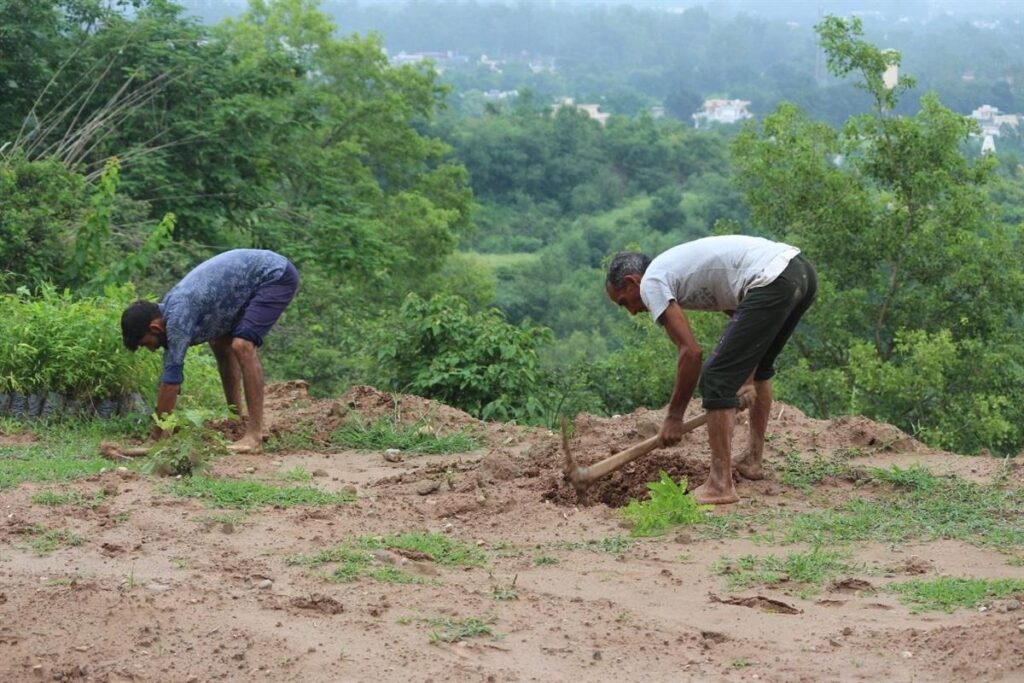A greener Katra welcomes pilgrims to the Vaishno Devi shrine
Grow-Trees.com’s ‘Trees for Shri Mata Vaishno Devi’ project is not only enriching biodiversity but generating employment for locals

As Navratri celebrations unfold around the country and devotees throng the holy shrine of Mata Vaishno Devi, they are discovering, to their surprise, a cleaner and greener Katra. This hilly destination in Jammu and Kashmir’s Reasi district, which is home to the revered shrine, draws multitudes of pilgrims annually. Due to deforestation and tourism-related development, the region has over the years witnessed environmental degradation, soil erosion, diminished water retention, ecological imbalance, pollution, and diminished biodiversity.
Recognising that reforestation is essential to restore ecological stability, social organisation Grow-Trees.com has planted over 26 thousand trees to expand the green cover in Katra. Their project, ‘Trees for Shri Mata Vaishno Devi,’ has also played a critical role in generating employment opportunities for the locals.
Pradip Shah, the co-founder of Grow-Trees.com, elucidates, “Katra has immense religious and ecological significance and our project ‘Trees for Shri Mata Vaishno Devi’ is an attempt to resolve some of the environmental challenges it has been facing. These include poor air quality and the ecological imbalance created by rapidly developing urban infrastructure. Targeted reforestation is now not only helping to create green spaces on degraded land but also creating a template for ecotourism that strikes the right balance between the needs of the pilgrims and the preservation of biodiversity.”
The trees planted include Khair (Acacia catechu), Bil Patri (Aegle marmelos), Neem (Azadirachta indica), Simbal (Bombax ceiba), Palash (Butea monosperma), Tunnu (Cedrela Toona), Gulmohar (Delonix regia), Amla (Emblica officinalis), and Safeda (Eucalyptus citriodora), among others.
Strategic plantation planning and adaptive measures helped address challenges like difficult terrain and erratic weather conditions, while local communities were engaged to ensure the long-term care of the planted saplings. “Their engagement is crucial, as they take on the responsibility for essential tasks such as regular watering, weeding, and monitoring the planted saplings. Additionally, they protect the saplings from potential threats, including grazing by cattle,” informs Mr. Shah.
Ankush Dogra, Site Supervisor, adds, “I’ve had the privilege of witnessing firsthand the positive changes we are bringing to Katra. Overseeing the planting process, I see the dedication and hard work of our community members, and it fills me with pride. This project not only combats air pollution and restores biodiversity, but it also creates jobs for the local people. Every tree we plant represents hope for a healthier environment. It’s inspiring to see the community come together to nurture these saplings.”
Local resident Asha Rani (38) discusses the community project enthusiastically and says, “Being involved in the tree plantation efforts has been incredibly rewarding for me. It’s amazing to see how our hard work can directly impact the environment. The project has also provided much-needed employment opportunities for many of us, helping to stabilise our livelihoods.”
Taro Devi (38) also participated in various plantation activities and not only supported her family with extra income but was also able to pay her children’s school fees. Such success stories have encouraged other women in the community to make a difference in their environment while empowering themselves economically. Additionally, as the trees mature, the community can benefit economically from timber and fruits, further supplementing their income.
Discussing the far-reaching effect of the project, Mr. Shah concludes, “As the community members prepare seedlings in nurseries, transport them to planting sites, and participate in the planting and maintenance of the trees, this engagement also empowers them with knowledge related to environmental management and conservation. The results of this collaborative synergy are now visible in Katra.”






